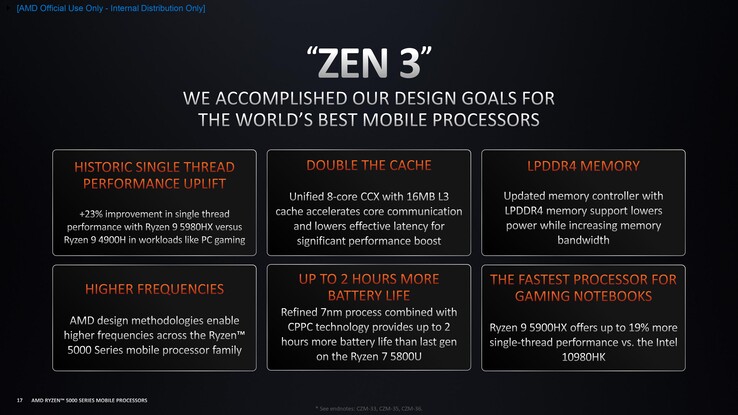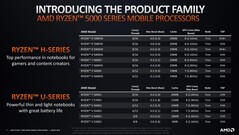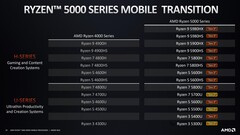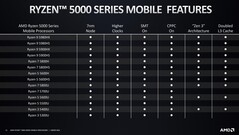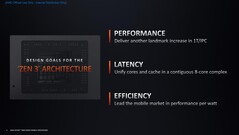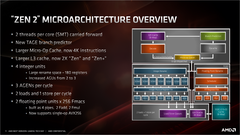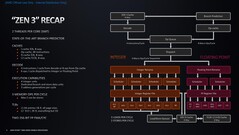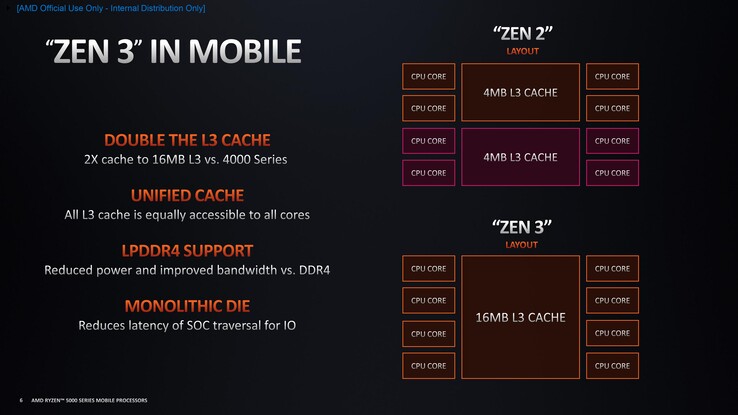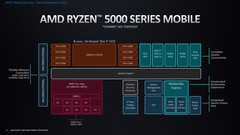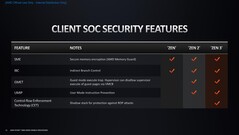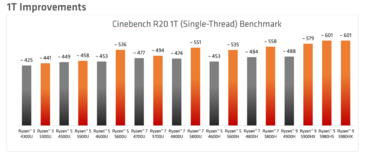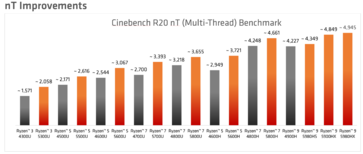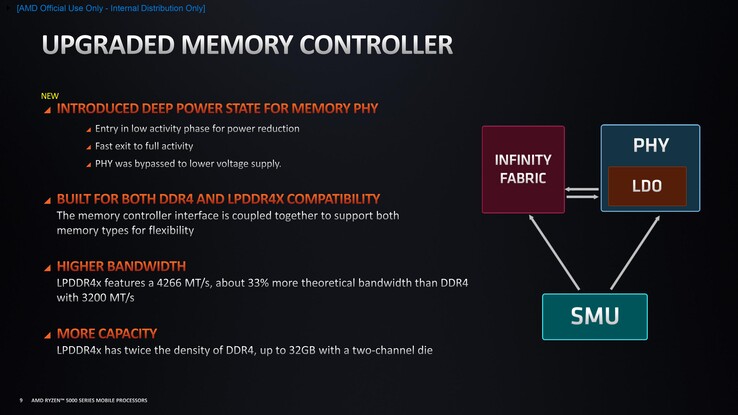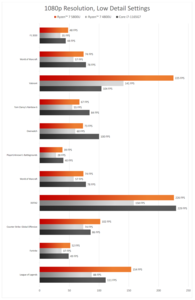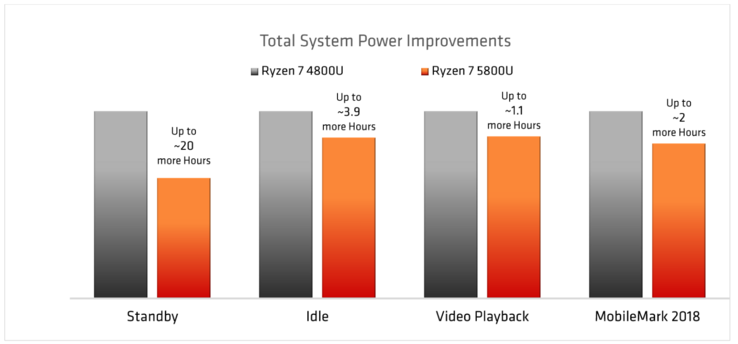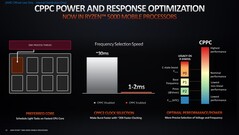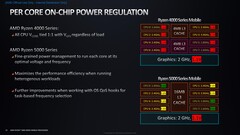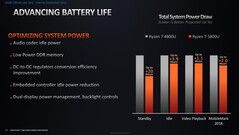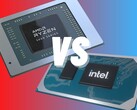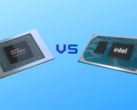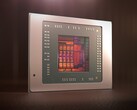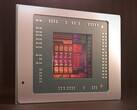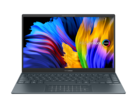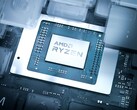AMD Zen 3 Cezanne Ryzen 5000 Mobile architecture deep dive — Improvements across SoC, cache topology, and power efficiency promise a great mobile experience
Introduction
It took AMD a year after the desktop launch to introduce Zen 2 Renoir mobile APUs. While Renoir APUs generally proved to be an overall better package compared to Intel Comet Lake-U and H-series chips, they still lagged behind in single-core performance. Also, there weren't many premium laptop offerings powered by AMD Renoir with even the gaming laptop class restricted to only NVIDIA GeForce RTX 2060 configurations at best.
All that changes this year.
In 2021, AMD could not only bring Zen 3 Ryzen 5000 Mobile APUs codenamed Cezanne within just a few months of Zen 3 Vermeer desktop launch but we are also seeing more premium laptops than before offering discrete GPU choices up to the flagship RTX 3080 Mobile.
Zen 3 Ryzen 5000 Mobile is fabbed on a 7 nm process and has a die size of 180 mm2 featuring 10.7 billion transistors. Cezanne brings several welcome changes, which we will discuss in detail in this article.
Ryzen 5000 SKUs
With Ryzen 4000 Renoir, AMD offered mobile APUs in U-series, H-series, and HS-series variants. While the U-series catered to thin and light notebooks with an emphasis on battery life, the H-series was targeted at mobile gamers and content creators. AMD also offered the HS-series with a constrained 35 W TDP to offer the best compromise between power and portability.
This year, Ryzen 5000 Cezanne introduces a new HX-series that offers 45 W+ TDP and overclockable SKUs for performance enthusiasts.
The U-series also includes a few Zen 2 SKUs, but they are now SMT-enabled and feature higher clocks while also offering Collaborative Processor Performance Control (CPPC) power management, which was a desktop-only feature until now.
AMD says the Ryzen 3 5300U offers better multi-core performance than a Core i7-1165G7 even as the entire H-series is said to beat the first generation Ryzen Threadripper 1900X in Cinebench R20.
Zen 3 architecture changes
One of the reasons AMD was able to bring out a mobile version of Zen 3 within just three months of the desktop launch is that the SoC topology remains the same between Renoir and Cezanne. Most of the architecture changes relate to more fine-tuned fetching and reduced latency along with energy consumption optimizations across all power states.
Zen 3 now comes with a higher branch predictor bandwidth and "no bubble" prediction capabilities along with a larger L1 branch target buffer that can now handle 1,024 entries for improved prediction latency. AMD said that a major goal on the front-end is to allow faster fetching for branchy, large-footprint code.
On the execution side, Zen 3 aims to reduce latency for float and int operations and allow higher instruction-level parallelism (ILP). Zen 3 now offers a +2 bandwidth for float and a +1 faster cycle for fused-multiply accumulate (FMAC) operations.
Renoir offered 2 loads and 1 store per cycle. Cezanne now increases that to 3 loads and 2 stores per cycle to allow for better prefetching and faster execution. Zen 3's translation lookaside buffer (TLB) now includes four more table walkers for improved virtual memory to physical memory translations.
Core/cache and SoC topology changes
Simlar to desktop Zen 3, the mobile variant also features 2x L3 cache and a consolidated CCX. Zen 3 now offers a 16 MB L3 cache, which all eight cores can quickly access sort of like a ring system. This reduces core-to-core and core-to-cache communication times, which should theoretically help with better gaming performance.
AMD said that it had Zen 3 Mobile already in mind while Zen 2 Mobile was being developed. By using the same SoC topology for both Renoir and Cezanne, AMD could add drop-in, pin-compatible support for Zen 3 Mobile so that OEMs can reuse their current Renoir designs and quickly offer Cezanne upgrades. This enabled AMD to tape-out Ryzen 5000 Mobile less than a year after the launch of Ryzen 4000 Mobile.
What took previously an year between desktop and mobile launches now happened in just three months. Though the SoC topology remains the same, Zen 3 allows for improved frequencies, residency, and power management.
The reduction in inter-core and inter-cache latency coupled with frequency increases and better process knowledge offers marked improvements in single-thread and gaming performance. Games that are largely single-threaded benefit from accessing a larger L3 cache that Cezanne offers.
Zen 3 also supports new security features such as GMET, UMIP, and CET.
Support for LPDDR4X RAM
Cezanne now brings support for LPDDR4X RAM, which while being power-efficient also offers 33% more theoretical bandwidth compared to DDR4. The new memory controller introduces a deep power state while also supporting both LPDDR4X and DDR4 memory.
The memory PHY includes a low-dropout (LDO) voltage regulator that allows for a low potential difference between the input and output voltage thereby reducing heat output while enabling a quick exit from low to full power state.
According to AMD, Zen 3 Mobile supports:
- Dual 64b channels of DDR4 up to 3200 MT/s (1 DPC SR or 1 DPC DR)
- Quad 32b channels of LPDDR4X up to 4266 MT/s
Imrpoved graphics capabilities
Cezanne uses the same Vega iGPU found in Renoir. However, this year's iteration comes with up to a 350 MHz increased boost clock and improved power efficiency. AMD says that the Vega 8 iGPU in the Ryzen 7 5800U should be up to 15% faster compared to the one in the Ryzen 7 4800U in 3DMark Time Spy.
AMD also showed some comparative iGPU gaming performance in popular eSports titles between the Ryzen 7 4800U, Ryzen 7 5800U, and the Core i7-1165G7 at 1080p low settings. Games such as DOTA 2 and Valorant seem to offer good gains with Cezanne.
Power consumption and battery life improvements
Improving power efficiency has been a key focus point in Cezanne with power consumption being reduced across all power states including standby, idle, video playback, and general productivity, according to AMD.
The company said that just swapping a Ryzen 4000 U-series processor with Ryzen 5000 U-series with no other system changes can offer up to 2 hours more battery life in general productivity. Standby time is now increased to up to 20 hours.
AMD said that several factors contribute to improved power efficiency in Ryzen 5000. Wherever possible, Vcore milliVolts in the pipeline are removed to save power and offer added thermal headroom, higher frequencies, and better battery life. The addition of a new deep power state to the memory controller that bypasses the PHY to a low voltage supply also plays its part here.
AMD desktop processors use a UEFI feature called Collaborative Processor Performance Control (CPPC) that allows the CPU itself to decide its own frequency-voltage (f/v) curve. This allows the CPU to change f/v dynamically within 1-2 ms instead of having to rely on the OS scheduler to select and change to pre-set pState values every 30 ms. This offers race-to-idle benefits as the threads can now be directed to more faster and efficient cores.
In Renoir, all available cores were tied to the active GPU voltage in a 1:1 Vcore to VGFX ratio irrespective of the load. In Cezanne, each processor core can choose its own Vcore for a particular frequency. Combined with CPPC, this results in a much more quicker transition to a low power state.
AMD also said that it has identified the oft-ignored audio pipeline to be an important power consuming factor. As such, it is working with OEMs to use audio codecs that allow for improved idling. Other aspects of laptop design that are also being considered include embedded controller idling, dual-display power management, and backlight controls.
AMD promises even more laptop designs from OEMs compared to last year, and we've already seen a glimpse of upcoming models during CES 2021. Watch out for our extensive reviews to know whether Zen 3 Ryzen 5000 Mobile really does live up to AMD claims.
Source(s)
AMD Press Brief




